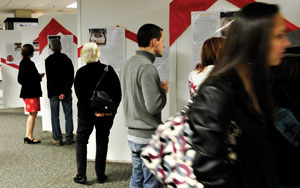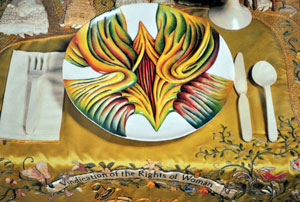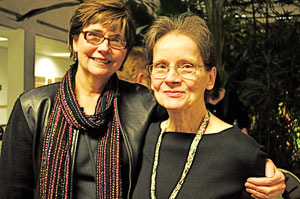Judy Chicago’s ‘The Dinner Party’ still shocks
Stephanie DuBois
The Signal Staff
A reception was held March 3 in celebration of the 30th anniversary of Judy Chicago’s The Dinner Party, a controversial multimedia installation and an iconic piece of American feminist art.
Created between 1974-1979 as a tribute to the accomplishments of women in history and educate viewers on the details that have been ignored or obscured over time, the installation is a triangular dining arrangement with ceramic plates and embroidered place settings for 39 honored women guests from the mythical past to the present. Still Chicago’s best-known work, her effort to establish respect for women’s contributions to history, was overshadowed by the unmistakable vaginal imagery throughout the piece.
“Some [local people], certainly, were offended. Some wrote letters to newspaper editors protesting the event. Many wouldn’t attend,” said Gretchen Mieszkowski, professor emerita of women’s studies.
Mieszkowski, along with many others, worked on the assembly of The Dinner Party when it was originally held at UHCL March 9, 1980.
“These were clitorises and vaginas,” Mieszkowski said. “Everyone accepted phallic imagery in art; think of the idealized male genitalia on Greek statues. But vaginal imagery?”
As only the second venue to host Chicago’s exhibition, UHCL opened the show to enthusiastic reviews as well.
“The Dinner Party drew more people to UHCL than have ever been here before or since: altogether 36,000 people,” Mieszkowski said. “It was a major, major event for the Houston arts community and for people interested in art from all over the South and West, and it was greeted with great excitement. I was proud when we brought the installation to UHCL and I remain proud that it was displayed here.”
Though an improbable location, UHCL daringly hosted the exhibition at a time when almost no one else would. The scale of the installation, the controversy surrounding it, and the amount of physical labor put into constructing the banquet made many Houston area museums turn The Dinner Party away.
“The first thing that I noticed after all the pieces were uncrated was that it wasn’t about the surroundings,” said Nick de Vries, professor of fine arts. “It wasn’t about the embroidery, it wasn’t about the tiles. It was an installation. It was everything about it.”
The original ceramic pieces are now permanently displayed at the Brooklyn Museum of Art. Prints on display are on loan from Donald Woodman and Judy Chicago and will be shown in Atrium I of the Bayou Building through March 24.





Comments are closed, but trackbacks and pingbacks are open.